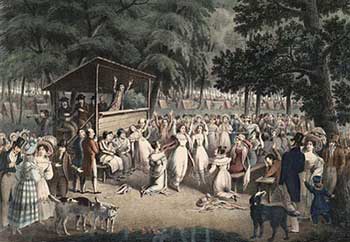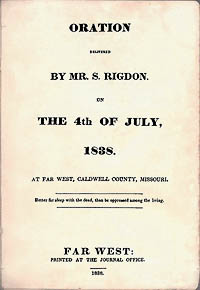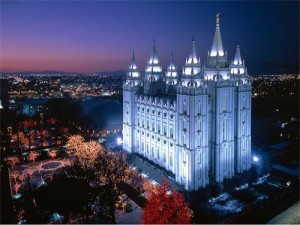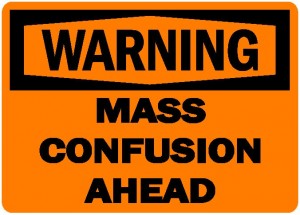Previously Aaron wrote about the current trend in Mormonism wherein Mormons tell Christians that Mormon beliefs are just the same as theirs – Mormon doctrines are the same as [fill-in-the-Christian-denomination] doctrines. I want to expand on a bit of what Aaron wrote, and add to it.
 Mormonism claims that in 1820 all Christian denominations were fighting against each other, not only for converts, but for their unique versions of spiritual truth. According to Joseph Smith,
Mormonism claims that in 1820 all Christian denominations were fighting against each other, not only for converts, but for their unique versions of spiritual truth. According to Joseph Smith,
“…so great were the confusion and strife among the different denominations, that it was impossible for a person young as I was, and so unacquainted with men and things, to come to any certain conclusion who was right and who was wrong. My mind at times was greatly excited, the cry and tumult were so great and incessant. The Presbyterians were most decided against the Baptists and Methodists, and used all the powers of both reason and sophistry to prove their errors, or, at least, to make the people think they were in error. On the other hand, the Baptists and Methodists in their turn were equally zealous in endeavoring to establish their own tenets and disprove all others. In the midst of this war of words and tumult of opinions, I often said to myself: What is to be done? Who of all these parties are right; or, are they all wrong together?” (Joseph Smith—History 1:8-10)
If every Christian denomination advocates for disparate doctrines, as Joseph Smith said, how can Mormon doctrines be the same as all of them?
When Joseph Smith inquired of God to know which church was right, he claims he was told that the creeds and doctrines of these churches were all wrong (Joseph Smith—History 1:19) – if Mormonism’s doctrines are just the same as these other churches, then reason dictates that Mormonism’s doctrines must also be all wrong – right?
At General Conference in April 2006 President James Faust quoted Apostle Dallin Oaks,
“The Church of Jesus Christ of Latter-day Saints has many beliefs in common with other Christian churches. But we have differences, and those differences explain why we send missionaries to other Christians” (“The Restoration of All Things,” Ensign, May 2006, 61)
How can these beliefs be different but the same?
Larry Dahl, then Associate Dean of Religious Education at BYU explained,
“Truly the bright light of the Restoration, bursting forth from the time of the Prophet Joseph Smith, makes clear the fundamental, eternal principles of the gospel of Jesus Christ. That light, revealed through the Prophet, replaced doctrinal shadows and clouds of error the world had inherited as a result of the great Apostasy nearly 2,000 years ago.” (Ensign, “The Morning Breaks, the Shadows Flee,” Ensign, April 1997, 12)
Apostle Boyd K. Packer expressed a similar idea during the commemoration of the 175th anniversary of the priesthood restoration in 2004. As reported by Church News,
“The [Mormon] Church is not merely an adjustment or correction of what had become Christianity following the Apostasy, President Packer said. “It is a replacement, a restoration of organization and authority to what had been when Christ established it.” (Church News, 5/22/04, 4)
If the “bright light of the Restoration” replaced the “doctrinal shadows and clouds of error” that non-Mormons believe — if Mormonism is a replacement of traditional Christianity — how can Mormon beliefs be the same as those in apostate Christianity?
In fact, in 2007 President Faust told a gathering of mission presidents and their wives,
“Our message is distinctly different because it contains the gospel restored through the Prophet Joseph Smith.” (Church News, 6/30/07, 5)
President Gordon B. Hinckley also explained that there are “many things of a doctrinal nature that distinguish this Church from all others” (Church News, 8/6/05, 2). Indeed, while encouraging Mormons to maintain their self-identification as Christians, Mr. Hinckley clarified,
“Now we may not be Christian by the standards of the world. In fact, we are not Christians by the standard under which they are Christian. If we were, there would have been no need for a restoration of the gospel. The restoration of the gospel occurred to correct all the mistakes of the past.” (Church News, 5/23/98, 5)
Members of the Mormon Church may be more comfortable telling Christians that Mormon beliefs are the same as their beliefs, but to say that is to be disloyal to the consistent teachings of Mormon leaders from Joseph Smith to current Mormon apostles, and to disdain the whole reason for The Restoration. The teachings of Mormonism are necessarily different from those of the allegedly apostate Christian world. Mormons, Christians invite you to gird up your loins and respectfully engage in the debate. Why? Because as Aaron said, “Truth matters. Life matters. Jesus matters.”




